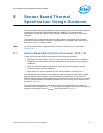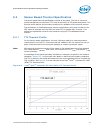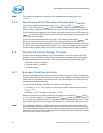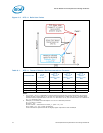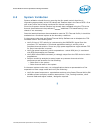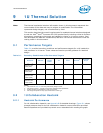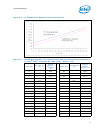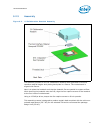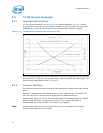
Thermal/Mechanical Specifications and Design Guidelines 73
Sensor Based Thermal Specification Design Guidance
8.5 System Validation
System validation should focus on ensuring the fan speed control algorithm is
responding appropriately to the DTS values and T
AMBIENT
data in the case of DTS 1.0 as
well as any other device being monitored for thermal compliance.
Since the processor thermal solution has already been validated using the TTV to the
thermal specifications at the predicted T
AMBIENT
, additional TTV based testing in the
chassis is not necessary.
Once the heatsink has been demonstrated to meet the TTV Thermal Profile, it should be
evaluated on a functional system at the boundary conditions.
In the system under test and Power/Thermal Utility Software set to dissipate the TDP
workload confirm the following item:
• Verify if there is TCC activity by instrumenting the PROCHOT# signal from the
processor. TCC activation in functional application testing is unlikely with a
compliant thermal solution. Some very high power applications might activate TCC
for short intervals this is normal.
• Verify fan speed response is within expectations - actual RPM (Ψ
CA
) is consistent
with DTS temperature and T
AMBIENT
.
• Verify RPM versus PWM command (or voltage) output from the FSC device is within
expectations.
• Perform sensitivity analysis to asses impact on processor thermal solution
performance and acoustics for the following:
— Other fans in the system.
— Other thermal loads in the system.
In the same system under test, run real applications that are representative of the
expected end user usage model and verify the following:
• Verify fan speed response vs. expectations as done using Power/Thermal Utility SW
• Validate system boundary condition assumptions: Trise, venting locations, other
thermal loads and adjust models / design as required.
§



